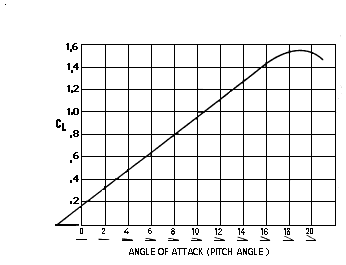30 degrees AOA .

30 degrees AOA is probably most common configuration when sailing square cross wind. Using example from previous post: 25kt board speed, true wind 25kt at 90 degrees and apparent wind 35kt at 45 degrees. To achieve 30 AOA you need to position your sail at 15 degrees relative to the board. Here is link for apparent wind calculator:
So, nothing unusual, very close to real life sailing situation.
Lets take a look how both airfoils respond to this. First - curved plate profile, conventional sail (pic. below).

Surprisingly compare to 40 AOA, air velocity magnitude improved for 1 m/s. Hi and low pressure difference is in decline as expected and center of hi pressure moves even more back, closer to trailing edge. Because inner surface has curved profile, center of lift generated from air impact (approx. 30%) moves back with its vector clocking backwards as well. At this point lift generated from lower surface still contributes to total lift, not as much as at 40 degrees, but still. This is when you start to feel backhand pressure. Unlike airplane aerodynamics, where best L/D ratio is around 3 to 8 degrees AOA, curved plate profile’s 30 degrees AOA is probably it’s shining moment.
Picture below represents thick airfoil exposed to the same conditions, 35kt apparent wind and 30 degrees AOA.

What is striking first, that despite AOA changed from 40 to 30, air velocity magnitude stays the same. Lower surface shows smooth gradual air pressure distribution, hi near leading edge/fading down at trailing edge with center of lift remaining stationary. Basically looking at two images (thin and thick profiles), it is clear that values of wing are better than values of curved plate in all parameters. Low pressure area 500Pa is lower and hi pressure 200Pa is higher. No change in vector of lift direction. According to modern aerodynamics full profile outperforms curved plate in L/D coefficient by just 0.2 and this is clearly visible in this study. Also other values like stationary center of lift and stable pressure redistribution over AOA change, make full profile superior to traditional curved plate profile. Next week we will take a look at 20 degrees AOA for both profiles, where things become more interesting.



















